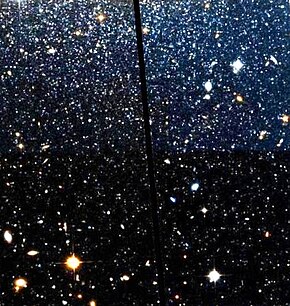| Cetus Dwarf | |
|---|---|
 | |
| Observation data (J2000 epoch) | |
| Constellation | Cetus |
| Right ascension | 00 26 11.0 |
| Declination | −11° 02′ 40″ |
| Distance | 2.46 ± 0.08 Mly (755 ± 24 kpc) |
| Apparent magnitude (V) | 14.4 |
| Characteristics | |
| Type | dSph |
| Other designations | |
| PGC 3097691 | |
Cetus Dwarf is a dwarf spheroidal galaxy. It lies approximately 2.46 Million light-years from Earth. It is an isolated galaxy of the Local Group, which also contains the Milky Way. All of the most readily observable stars in the galaxy are red giants.
History
The Cetus Dwarf was discovered in 1999 by Alan B. Whiting, George Hau and Mike Irwin and was found to be a member of the Local Group.
Characteristics
As of 2000, no known neutral hydrogen gas has been found that is related to the Cetus dwarf galaxy.
References
- ^ "NASA/IPAC Extragalactic Database". Results for Cetus Dwarf. Retrieved 2006-12-23.
- ^ McConnachie, A. W.; Irwin, M. J.; Ferguson, A. M. N.; Ibata, R. A.; Lewis, G. F.; Tanvir, N. (2005). "Distances and metallicities for 17 Local Group galaxies". Monthly Notices of the Royal Astronomical Society. 356 (4): 979–997. arXiv:astro-ph/0410489. Bibcode:2005MNRAS.356..979M. doi:10.1111/j.1365-2966.2004.08514.x.
- Alan B. Whiting; George Hau; Mike Irwin (31 August 1999). "A New Local Group Galaxy in Cetus". The Astronomical Journal. 118 (6): 2767–2774. Bibcode:1999AJ....118.2767W. doi:10.1086/301142.
- Hartmut Frommert. "Cetus Dwarf". SEDS.
- ^ van den Bergh, Sidney (April 2000). "Updated Information on the Local Group". The Publications of the Astronomical Society of the Pacific. 112 (770): 529–536. arXiv:astro-ph/0001040. Bibcode:2000PASP..112..529V. doi:10.1086/316548. S2CID 1805423.
External links
- The Cetus Dwarf on WikiSky: DSS2, SDSS, GALEX, IRAS, Hydrogen α, X-Ray, Astrophoto, Sky Map, Articles and images